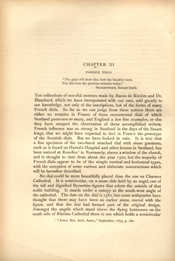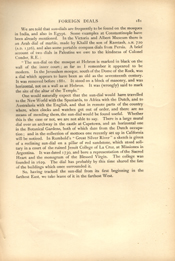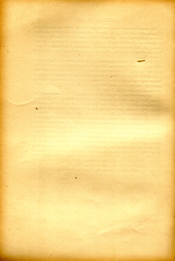CHAPTER XI
FOREIGN DIALS
"Thy glass will show thee how thy beauties wear,
Thy dial how thy precious minutes waste."
SHAKESPEARE, Sonnet lxxvii.
THE collections of sun-dial mottoes made by Baron de Rivière and Dr. Blanchard, which we have incorporated with our own, add greatly to our knowledge, not only of the inscriptions, but of the forms of many French dials. So far as we can judge from these notices there are either no remains in France of those monumental dials of which Scotland possesses so many, and England a few fine examples, or else they have escaped the observation of these accomplished writers, French influence was so strong in Scotland in the days of the Stuart kings, that we might have expected to find in France the prototype of the Scottish dials. But we have looked in vain. It is true that a fine specimen of the two-faced attached dial with stone gnomons, such as is found on Heriot's Hosptial and other houses in Scotland, has been noticed at Rouelles 1 in Normandy, above a window of the church, and is thought to date from about the year 1500, but the majority of French dials appear to be of the simple vertical and horizontal types, with the exception of some curious and elaborate constructions which will be hereafter described.
No dial would be more beautifully placed than the one on Chartres Cathedral. It is semicircular, on a stone slab held by an angel, one of the tall and dignified Byzantine figures that adorn the outside of that noble building. It stands under a canopy at the south-west angle of the cathedral. The date on the dial is 1582, but some antiquaries have thought that there may have been an earlier stone, coeval with the figure, and that the dial had formed part of the original design. Amongst the angels which stand above the flying buttresses on the south side of Rheims Cathedral there is one which holds a semicircular
1 "Journ. Brit. Arch. Assoc.," September, 1873, p. 280.
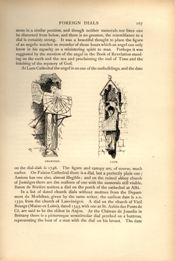
[Full Image]
CHARTRES.
LAON.
stone in a similar position, and though neither numerals nor lines can be discerned from below, and there is no gnomon, the resemblance to a dial is certainly strong. It was a beautiful thought to place the figure of an angelic watcher as recorder of those hours which an angel can only know in his capacity as a ministering spirit to man. Perhaps it was suggested by the mention of the angel in the Book of Revelation standing on the earth and the sea and proclaiming the end of Time and the finishing of the mystery of God.
At Laon Cathedral the angel is on one of the outbuildings, and the date on the dial-slab is 1748. The figure and canopy are, of course, much earlier. On Falaise Cathedral there is a dial, but a perfectly plain one; Amiens has one also, almost illegible; and on the ruined abbey church of Jumiéges there are the outlines of one with the numerals still visible. Baron de Rivière notices a dial on the porch of the cathedral at Albi.
In a list of dated church dials without mottoes from the Department du Morbihan, given by the same writer, the earliest date is A.D. 1550, from the church of Lanvénégen. A dial on the church of Vieil Beauge (Maine-et-Loire), dated 1543, with one at St. Aubin des Ponts de Cé, are said to be the oldest in Anjou. At the Château de Josselin in Brittany there is a picturesque semicircular dial perched on a buttress, representing the bust of a man with the dial on his breast. The date

[Full Image]
CHÂTEAU DE JOSSELIN.
below is 1578. A dial once stood on the chapel of the Château de St. Foy, near Lyons, and was removed to the Musée Lapidaire at Lyons when the chapel was destroyed about fifty or sixty years ago.
In the old Place des Cordeliers at Lyons there formerly stood a tall column surmounted by a statue of Urania, holding a long gnomon which showed the hour of noon on a meridian line. The square was the rendezvous for all the wheeled traffic between Switzerland and Franche Comté, and the whole space between the column and the church of the Cordeliers was wont to be filled by the long chars of the country. The column was taken down in 1858.
Paris in former days possessed a great number of dials, several of which are noticed in the collection of mottoes. Only a few remain. One of these is in the first court of the Institut, formerly the Collège des Quatre Nations, founded by Cardinal Mazarin. It is inscribed: "Veteris Collegii/ Mazarinaci / Horarium Solare / Anno Domini / MDCCCLVI / Restitutum /." Fr. Bedos de Celles gives in his "Gnomonique Pratique" (1771) an engraving of a vertical dial, 12 feet high by 10 feet 6 inches wide, made by him for the Abbey of St. Denis, and set up there in 1765.
A dial of very barbarous design was on the Bastille. It had for supporters the figures of a man and woman chained together by hands, feet, and neck, the chains also forming a wreath round the dial and the inscription belonging to it. The inscription has not been preserved, but an appropriate one might readily be supplied from the book of Job: "A land of darkness and of the shadow of death, and where the light is as darkness."
The column erected by Jean Bullant for Catherine de' Medici at the Hôtel de la Reine, afterwards the Hôtel de Soissons, and later the Halles au Blé, which served as an observatory for her astrologer, has now been built into the Halles. Originally there was a large ring of metal round it, on which the hours were shown by a ray of light passing over them. In the middle of the eighteenth century the astronomer Pingré drew lines for two dials upon the column, but none of these remain.
In 1763 an elaborate arrangement of meridian and hour lines, with tables of comparison showing the time of day in different parts of the world, etc., was drawn on the staircase walls of the Lycée at Grenoble by a learned Jesuit, probably under the direction of the celebrated Athanasius Kircher, who was in France at that time. The lines were traced
on the different flights of stairs, and the light was thrown on them from mirrors placed horizontally over the windows. By this means there was shown in lines and letters of different colours: (1) the French hours; (2) the Italian hours; (3) the Babylonian hours; (4) the signs of the Zodiac; (5) the months; (6) the four seasons; (7) the hours of sunrise and sunset. On the first flight there was also to be seen: (1) the Zodiac signs with their attributes; (2) the calendar of the Blessed Virgin Mary and her seven feasts; (3) a table of hours, or horologium universale, showing the time of day at twelve other towns beside Grenoble, and in ten countries; this was 8 feet high and 10 feet wide; (4) a horologium novum, or table to find the place of the sun and moon in the universe, of the same size as the other table; (5) a calendar of Jesuit saints.
On the second flight of stairs there was: (1) a calendar of the exploits of Louis XIV.; (2) a table to find the days of the moon; (3) a table of epacts from 1674 to 1721.
The meridian itself consisted of oblique lines traced on the side walls and vaulting of the staircase. Below the side window were the words: "Tempori et Æternitate, Picturus Anno 1673. Restauratum Prime 1755. Iter 1855." When the last account of these instruments was written, neither the gnomons nor their supports remained.
An ingenious dial was set up at Besançon in the eighteenth century by M. Bizot, a counsellor and a distinguished mathematician. The dial represented an angel holding a child in his right hand, and with his left hand pointing to the heavens. The hour lines and numerals were left in open work, and the rays of light which passed through them fell on the finger of the angel and showed the time of day. There was a slight projecting roof of zinc which protected the dial and cast a shadow over the head and hand of the angel. This dial was described in the "Journal des Savants" by the astronomer Lalande. M. Bizot made a second dial in the church of the Madeleine at Besançon, and there the light fell through a hole in a metal plate inserted in a window upon hour lines chiselled on the floor.
In the churchyard of Brou, near Bourg-en-Bresse, a curious sun-dial was made for the use of the workmen who built the church known to us through Matthew Arnold's poem:
"On Sundays at the matin chime
The Alpine peasants, two and three,
Climb up here to pray:
Burghers and dames, at summer's prime,
Ride out to church from Chambery,
Dight with mantles gay;
But else it is a lonely time
Round the church of Brou."
The building was begun in 1506. The dial was a horizontal circle, 33 feet in diameter. The spectator himself formed the gnomon, and by standing on a particular spot on the initial letter which indicated the current month, saw his shadow fall upon the hour he wished to ascertain. The hours were marked in bricks, which were nearly worn away when M. Lalande replaced them by stones. This was nearly a century and a half ago, and probably by this time the stones have also been worn away and displaced, and the hours are known no more.
A dial was made in a similar manner at Dijon early in the nineteenth century by M. Caumont. There were twenty-four stone slabs placed in a circle on the ground, and within them were four octagonal blocks which gave the points of the compass, and slabs of 6 feet long to mark the meridian and the east and west lines. The outer slabs were numbered according to the hours, and the signs of the Zodiac were engraved on the blocks. The observer, by placing an upright stick on the meridian line opposite the initial letter of the month, could ascertain the correct time. In 1840 this dial had to be removed to make way for the building of the citadel, and after some years was placed at the end of the promenade in the Parc, near the river Ouche. The account of it was written in 1856.
With regard to the artistic merit of the French dials, it will easily be believed that some of the designs are very fine, particularly in those that are cut in slate or engraved in metal. M. de Rivière gives an example of a slate slab beautifully carved in relief, dated 1655, which is now in the museum at Moulins.1
Slate is a favourite substance for diallers to work upon. On a vertical dial on the church at Coutures (Maine-et-Loire) each of the hour lines terminates in a fleur-de-lys, and there follows an inscription:
FAIT . PAR . MOY:
JACQVES . ROVSSE
M . SĒR . HOME PRO
CVREVR . LE Iier I . 1691
IE . DE . MON . MIEV . DEVISE
LE . MILIEV . DV . SOLEIL.
[Fait par moi Jacques Rousse, merchant sergier, homme procureur, le Iier Janvier, 1691. Je de mon mieux devise le milieu du soleil.]
1 "Bull: Mon." vol xliv., p. 623.
A finely-engraved leaden plate is in the museum at Varzy. M. Grasset, the curator, published a description of it,1 but was unable to decipher the last line of the inscription. The hour lines are in relief, and above them are the instruments of the Passion, viz., the crown of thorns, lance, scourge, reed and sponge, hammer and nails, with the cock, the ear of Malchus, thirty silver pieces, dice and lantern. Below the cross is a shield with the monogram "A. M.," and an inscription in Gothic characters is round the dial:
GUILLERMUS LEGRANT PRESBYTER CVM CHRISTO VIVAT FILICITER. AMEN. CYMAR . . . ET SANS NVILLE POSE FU FAIT 1514.
In a country house at Tourcil, belonging in 1876 to M. Henri Joubert, a horizontal sun-dial of lead, with ornamental engraving in the corners, was preserved. The style was of copper, the numerals in Roman letters, and in the centre was inscribed:
VIVE JESUS. 1607
M. LALOY. LIMOGES.
A very finely-engraved horizontal dial is described by M. Planté.2 It was found at Craon, and had belonged to the abbot of St. Serge, Réné de Briolay, to whom it was dedicated by the engraver, D. Jacobus Moraine, Carthusian, A.D. 1643. The plate was of copper gilt, a square of 33 centimètres, ornamented in the angles and about the centre with a charming arabesque design. In the centre of all are the arms of the abbot, with his name and anagram surrounding them: "Renatus Brioleus. Ut Rosa lenis rube."
Around the dial are the following lines, which contain the same anagram:
"Ornant stemma rosæ solis virtute rubentes,
Ut Rosa sic nobis lenis odore rube.
Dum tua sol lustrat solaria præsul amande
Totus divino solis amore rubes."
"Roses adorn the wreath, blushing with the sunshine,
Do thou, like the rose, blush for us, gentle in perfume,
While the sun illumines thy sun-dials, beloved patron,
Thou dost blush all over with the sun's divine love."
The arms are three roses with a star in the centre. There is also a dedicatory inscription.
1 "Cadran solaire en plomb, portant la date 1514."
2 "Gnomons et clepsydres," par Jules Planté, Laval, 1890.
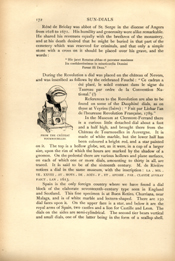
[Full Image]
FROM THE CHÂTEAU TOURNOUELLES.
Réné de Briolay was abbot of St. Serge in the diocese of Angers from 1628 to 1671. His humility and generosity were alike remarkable. He shared his revenues equally with the brethren of the monastery, and at his death desired that he might be buried in that part of the cemetery which was reserved for criminals, and that only a simple stone with a cross on it should be placed over his grave, and the words:
"Hic jacet Renatus abbas et peccator maximus
Ita confidentissimus in misericordia Domini
Pareat illi Deus."
During the Revolution a dial was placed on the château of Nevers, and was inscribed as follows by the celebrated Fouché: "Ce cadran a été placé, le soleil entrant dans le signe du Taureau par ordre de la Convention National." (!)
References to the Revolution are also to be found on some of the Dauphiné dials, as on those at Veyrins (Isère): "Fait par Liobar l'an de l'heureuse Revolution Française, 1789."
In the Museum at Clermont-Ferrand there is a curious little detached dial about a foot and a half high, and brought there from the Château de Tournouelles in Auvergne. It is made of white marble, but the lower half has been coloured a bright red, and a star painted on it. The top is a hollow globe, set, as it were, in a cup of a larger size, upon the rim of which the hours are marked by the shadow of a gnomon. On the pedestal there are various hollows and plane surfaces, on each of which one or more dials, amounting to thirty in all, are traced. It is said to be of the sixteenth century. M. de Rivière notices a dial in the same museum, with the inscription : LA . MIL . VE . XXVIII . AV . MOYS . DE . AOUS . F . ET . APOSSE . PAR . CLAVDE AVVRAY . FAICT . LAN . 1613.
Spain is the only foreign country where we have found a dial block of the elaborate seventeenth-century type seen in England and Scotland. This fine specimen is at Buen Retiro, Churriana, near Malaga, and is of white marble and lectern-shaped. There are 150 dial faces upon it. On the upper face is a star, and below it are the royal arms of Spain, two castles and a lion for Castille and Leon. The dials on the sides are semi-cylindrical. The second tier bears vertical and small dials, one of the latter being in the form of a scallop shell.
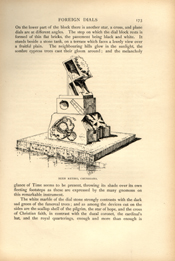
[Full Image]
BUEN RETIRO, CHURRIANA.
On the lower part of the block there is another star, a cross, and plane dials are at different angles. The step on which the dial block rests is formed of thin flat bricks, the pavement being black and white. It stands beside a stone tank, on a terrace which faces a lovely view over a fruitful plain. The neighbouring hills glow in the sunlight, the sombre cypress trees cast their gloom around; and the melancholy glance of Time seems to be present, throwing its shade over its own fleeting footsteps as these are expressed by the many gnomons on this remarkable instrument.
The white marble of the dial stone strongly contrasts with the dark sad green of the funereal trees; and as among the devices cut on the sides are the scallop shell of the pilgrim, the star of hope, and the cross of Christian faith, in contrast with the ducal coronet, the cardinal's hat and the royal quarterings, enough and more than enough is
suggested for serious meditation to anyone who visits this remarkable time-reckoner.
We have hardly any other dials from Spain. That of Charles V. at Yuste has been already noticed. A vertical one, surmounted by a royal crown, and placed on the top of a tower above a window, was sketched some thirty years ago in the cloisters of Burgos Cathedral; and another vertical dial on one side of a stone, surmounted by a pinnacle, was seen on a grass plot near the railway station at Pancorba. It seems strange that no others should have been noticed, and that no vestiges of the work of the Arab astronomers should remain amongst the Moorish buildings of Andalusia. But the power of whitewash is great, and the average Spaniard, perhaps, did not much care whether the flight of Time was recorded for him or no.
In Italy it is different. Sun-dials abound, or did abound till a few years ago, when decay and whitewash overtook many of them. Yet, even there, we have few records of fine detached dials, though in the seventeenth and eighteenth centuries Italy produced several writers on gnomonics, and some members of the religious orders made a special study of the subject. It must be acknowledged that the researches which we have been able to make on the spot have been very partial and perfunctory. In recording the mottoes, of which there were many to be seen on mural dials, the uninscribed dials were apt to be overlooked. Two specimens have, however, been noticed which resemble in their form the hollowed hemicycle of the ancients. One of them is on a convent at Assisi; another, standing on a little column, a cippo, is perched on the corner of a shop roof on the Ponte Vecchio at Florence.
There is also at Florence the interesting white marble vertical dial which projects from the façade of the church of Sta. Maria Novella, and bears the following inscription : COSM . MED . MAG . ETR . DUX . NOBILIUM ARTIUM STUDIOSUS, ASTRONOMIAE STUDIOSUS DEDIT, ANNO D. M.D.LXXII. [Cosmo Medici, Grand Duke of Etruria, student of the ennobling arts, gave this to the students of astronomy, A.D. 1572.] A corresponding slab on the left-hand side of the portal shows the "Armilla di Tolomeo," or sphere of Ptolemy, for observing the ingress of the sun into the first point of Aries. Both these dials were the work of Fra Egnatio Danti of the Dominicans, to which order the church and convent belonged. 1
The church of Sta. Maria Novella was called by Michael Angelo,
1 Both of these instruments are described in the sixth part of his book "Dell 'uso et fabrica dell' Astrolabio," 3rd ed., Florence, 1578.
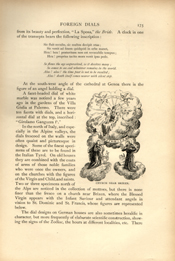
[Full Image]
CHURCH NEAR BRIXEN.
from its beauty and perfection, "La Sposa," the Bride. A clock in one of the transepts bears the following inscription:
Sic fluit occulte, sic multos decipit ætas;
Sic venit ad finem quidquid in orbe manet,
Heu! heu! præteritum non est revocabile tempus;
Heu! proprius tacito mors venit ipsa pede.So flows the age unperceived, so it deceives many;
So comes to an end whatever remains in the world.
Alas! alas! the time past is not to be recalled;
Alas! death itself comes nearer with silent step.
At the south-west angle of the cathedral at Genoa there is the figure of an angel holding a dial.
A facet-headed dial of white marble was noticed a few years ago in the gardens of the Villa Giulia at Palermo. There were ten facets with dials, and a horizontal dial at the top inscribed: "Girolamo Ganguzza fc."
In the north of Italy and especially in the Alpine valleys, the dials frescoed on the walls were often quaint and picturesque in design. Some of the finest specimens of these are to be found in the Italian Tyrol. On old houses they are combined with the coats of arms of those noble families who were once the owners, and on the churches with the figures of the Virgin and Child, and saints. Two or three specimens north of the Alps are noticed in the collection of mottoes, but there is none finer than the fresco on a church near Brixen, where the Blessed Virgin appears with the Infant Saviour and attendant angels in vision to St. Dominic and St. Francis, whose figures are represented below.
The dial designs on German houses are also sometimes heraldic in character, but more frequently of elaborate scientific construction, showing the signs of the Zodiac, the hours at different localities. etc. There
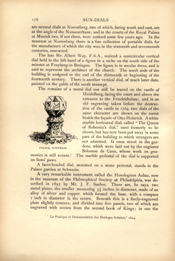
[Full Image]
PALACE, SCHWERIN.
are several dials at Nuremberg, two of which, facing south and east, are at the angle of the Nassauerhaus; and in the courts of the Royal Palace at Munich two, if not three, were noticed some few years ago. In the museum at Nuremberg there is a fine collection of portable dials, for the manufacture of which the city was, in the sixteenth and seventeenth centuries, renowned.
The late Mr. Albert Way, F.S.A., noticed a semicircular vertical dial held in the left hand of a figure in a niche on the south side of the minster at Freyberg-in-Breisgau. The figure is in secular dress, and is said to represent the architect of the church. The south aisle of the building is assigned to the end of the thirteenth or beginning of the fourteenth century. There is another vertical dial, of much later date, painted on the gable of the south transept.
The remains of a mural dial can still be traced on the castle of Heidelberg, facing the court and above the entrance to the Friedrichsbau; and in an old engraving taken before the destruction of the castle in 1764, two dials of the same character are shown on the turret beside the façade of Otto Heinrich. A white marble horizontal dial, called "The Queen of Bohemia's dial," used formerly to be shown, but has now been put away in some part of the building to which strangers are not admitted. It once stood in the gardens, which were laid out by the engineer Solomon de Caux, whose work on gnomonics is still extant.1 The marble pedestal of the dial is supported on lion's paws.
A facet-headed dial, mounted on a stone pedestal, stands in the Palace garden at Schwerin.
A very remarkable instrument, called the Horologium Achaz, now in the museum of the Philosophical Society at Philadelphia, was described in 1895 by Mr. J. F. Sachse. There are, he says, two metal plates, the smaller measuring 5 3/4 inches in diameter, made of an alloy of silver and copper, which formed the base, with a compass 1 inch in diameter in the centre. Beneath this is a finely-engraved plate slightly concave, and divided into five panels, two of which are engraved with scenes from the second book of Kings; in one the
1 "La Pratique et Demonstration des Horloges Solaires," 1624.
prophet Isaiah is pointing to a vertical dial, and in the other healing the king. In the centre is written:
"Notat concha isthac hemiciclea capitis 38 Esaia miracvlvm: nam hanc si acqva labrvm vsqve impleveris vmbra solis 10 imo: 20 gradibvs retrorsvm fertvr signvm ac gradvm solis: quin etiam horam diei vvlgarem qvamcvnqve vna cvm planetarvm qvas vocant horas denvncians."
[This semicircular shell explains the miracle of the 38th chapter of Isaiah. For if you fill it to the brim with water, the shadow of the sun is borne backward by ten or twenty degrees. Moreover it indicates any common hour of the day whatever, together with what they call hours of the planets.]
The larger piece is a basin-shaped plate made of brass or gunmetal, with a flat movable rim 1 inch wide. Upon this are engraved the signs of the Zodiac. On the reverse of this rim, which surrounds the large basin, is engraved as follows:
"Christophorvs Schissler, geometricvs ac astronomicvs artifex, Avgvstae Vindelicorvm, faciebat anno 1578."
"The centre or concave part of the dial is 10 inches in diameter, and geometrically divided into the different planetary hours. The depth of the basin is 1 3/4 inches, and the whole formed the dial." A brass figure about 3 inches high, with the left hand extended to hold the gnomon, is placed on the rim. "The instrument was formerly used for calculating nativities, . . . and when filled with water to the brim, the shadow was advanced or retarded as many degrees as the angle of refraction."
Christopher Schissler was a brassworker and also an astronomical and geometrical "werkmeister" at Augsburg. The four large sun-dials which he made for the Perlachthurm, a tall watch-tower, in 1561, are still to be seen. Some of his smaller instruments may be found in collections such as that at the British Museum. His greatest work, a quadrant, dated 1569, was placed in the museum at Dresden. Schissler seems to have discovered the laws of refraction some fifty years before they were made known generally by the mathematicians.
The Horologium Achaz belonged in the seventeenth century to Anton Zimmerman, a distinguished astronomer, and magister of the Rosicrucians, who was on the point of emigrating to America with the members of his society when he died, between the years 1691-93. His effects had been placed on shipboard, and were taken to America by Johannes Kelpius, who was the next elected magister. The Rosi-
crucians settled on the shores of the Wissahickon, near Philadelphia, and the observatory or "lantern" which they set up for the study of the stars was the first regular observatory established in America. The last surviving member of the Rosicrucians, Christopher Witt, who had received the scientific instruments from Kelpius, gave some of them to the Philosophical Society of Philadelphia, of which Benjamin Franklin was president. Amongst them, no doubt, was this "Horologium Achaz." Mr Sachse says he has searched Europe in vain to find a duplicate.1
There is a fine collection of Scandinavian dials in the Northern Museum at Stockholm. A letter of inquiry about this was most courteously replied to by Dr. A. Hazelius, the curator, as follows:
"Nordiska Museet has a great number of sun-dials from the latter part of the sixteenth century to far on in the nineteenth century. Their size, as well as shape and material, vary. We have sun-dials in pocket size, and dials that have been intended for walls and pillars; one has even been affixed to a mile-post. The form is usually quadratic, but cubes are not unusual. The material of which they are made is, as above mentioned, very varying. The ornamentation consists usually of escutcheons with ideographs, initials, and sometimes of motives of plants in different styles and manner. Mottoes do not often occur." Dr. Hazelius also mentions the dial with a Runic inscription, dated 1754, which Prof. Stephens described in 1877. 2 It is of marble, nearly a foot square, and was found in 1876 at Norrköping. "A line of modern Runic runs all round the four edges, and gives a rule how to arrange the gnomon in leap-year."
That the sun-dial was once as much at home in the churchyards of Sweden as of those of Great Britain we may see from Bishop Tegnier's lines:
"Even the dial, that stood on a hillock among the departed
(There full a hundred years had it stood) was embellished with blossoms,
Like to the patriarch hoary, the sage of his kith and the hamlet,
Who on his birthday is crowned by children and the children's children,
So stood the ancient prophet, and mute with his pencil of iron
Marked on the tablet of stone, and measured the time and its changes,
While all around at his feet an eternity slumbered in quiet."
Children of the Lord's Supper (Longfellow's trans.).
The wish which the philanthropist John Howard expressed on his
1 "Pro. Am. Phil. Soc.," vol. xxxvi., 1895. "Horologium Achaz."
2 "Monats blad," Nos. 67 and 68, also "Old Northern Scandinavian Monuments."
deathbed, to have a sun-dial placed on his grave, was not fulfilled after his interment. He was buried at the spot he had selected, near the village of Dophinovka, now called Stepanovka, six versts north of Kherson, and a monument, consisting of a brick pyramid inscribed with his name, was placed on the grave by his friends. An obelisk, 30 feet high, was, however, erected in memory of Howard by the Emperor Alexander I., near the Church of the Assumption at Kherson. On one side there is a sun-dial, showing the hours from ten to two, and on the other a portrait medallion of Howard. There is also an inscription in Russian and Latin:
Howard
died on the 20th January
in the year 1790
in the 65th year of his age
Vixit propter alios
Alios salvos fecit.
Howard's last wishes were thus gracefully remembered, though the sun-dial was not upon his grave.
This, and the dial brought from Kelbouroun Spit, noticed in the collection of mottoes, are the only specimens which we have from Russia.
The great equatorial dial at Delhi, constructed in 1724 by Jey Singh, Rajah of Jeypore, and called by him the prince of sun-dials, one of the most marvelous specimens in the world, almost defies description. We are told that the dimensions of the gnomon are as follows:
ft. in. Length of hypothenuse 118 5 " base 104 0 " perpendicular 56 7
The gnomon is of solid masonry edged with marble, and the shadow is thrown upon a graduated circle, also of marble.
"At a short distance, nearly in front of the great dial, is another building in somewhat better preservation; it is also a sun-dial, or rather several dials combined in one building. In the centre is a staircase leading to the top, and its side walls form gnomons to concentric semicircles, having a certain inclination to the horizon, and they represent meridians removed by a certain angle from the meridian of the observatory; the outer walls form gnomons to graduated quadrants, one to the east and one to the west; a wall connects the four gnomons, and
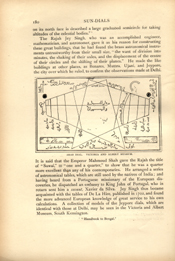
[Full Image]
ARAB DIAL. VICTORIA AND ALBERT MUSEUM.
on its north face is described a large graduated semicircle for taking altitudes of the celestial bodies."1
The Rajah Jey Singh, who was an accomplished engineer, mathematician, and astronomer, gave it as his reason for constructing these great buildings, that he had found the brass astronomical instruments untrustworthy from their small size, "the want of division into minutes, the shaking of their axles, and the displacement of the centre of their circles and shifting of their planes." He made the like buildings at other places, as Benares, Muttra, Ujani and Jeypore, the city over which he ruled, to confirm the observations made at Delhi. It is said that the Emperor Mahmoud Shah gave the Rajah the title of "Sawai," = "one and a quarter," to show that he was a quarter more excellent than any of his contemporaries. He arranged a series of astronomical tables, which are still used by the natives of India; and having heard from a Portuguese missionary of the European discoveries, he dispatched an embassy to King John of Portugal, who in return sent him a savant, Xavier da Silva. Jey Singh thus became acquainted with the tables of De La Hire, published in 1702, and found the more advanced European knowledge of great service to his own calculations. A collection of models of the Jeypore dials, which are identical with those at Delhi, may be seen in the Victoria and Albert Museum, South Kensington.
1 "Handbook to Bengal."
We are told that sun-dials are frequently to be found on the mosques in India, and also in Egypt. Some examples at Constantinople have been already mentioned. In the Victoria and Albert Museum there is an Arab dial of marble, made by Khalil the son of Ramtash, A.H. 720 (A.D. 1326), and also some portable compass dials from Persia. A brief account of two dials in Palestine we owe to the kindness of Colonel Conder, R. E.:
"The sun-dial on the mosque at Hebron is marked in black on the wall of the inner court; as far as I remember it appeared to be modern. In the Jerusalem mosque, south of the Dome of the Rock, was a dial which appears to have been as old as the seventeenth century. It was removed before 1881. It stood on a block of masonry, and was horizontal, not on a wall as at Hebron. It was (wrongly) said to mark the site of the altar of the Temple."
One would naturally expect that the sun-dial would have traveled to the New World with the Spaniards, to Africa with the Dutch, and to Australasia with the English, and that in remote parts of the country where, when clocks and watches get out of order, and there are no means of mending them, the sun-dial would be found useful. Whether this is the case or not, we are not able to say. There is a large mural dial over an archway in the castle at Capetown, and an horizontal one in the Botanical Gardens, both of which date from the Dutch occupation; and in the collection of mottoes one recently set up in California will be noticed. In Rumbold's "Great Silver River" a sketch is given of a reclining sun-dial on a pillar of red sandstone, which stood solitary in a court of the ruined Jesuit College of La Cruz, at Missiones in Argentina. It was dated 1730, and bore a representation of the Sacred Heart and the monogram of the Blessed Virgin. The college was founded in 1629. The dial has probably by this time shared the fate of the buildings which once surrounded it.
So, having tracked the sun-dial from its first beginning in the farthest East, we take leave of it in the farthest West.
